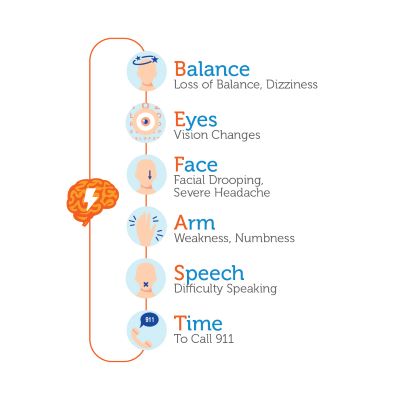Stroke: What You Need to Know
Posted May 22, 2023 by Dr. Madihah Hepburn, Medical Director, Neurocritical Care.

Updated May 2025
Strokes are very common, with one occurring every 40 seconds United States. A stroke is a medical emergency requiring immediate attention – the longer symptoms are left untreated, the more damage a stroke can cause. Since fast care is necessary, knowing the signs and symptoms is essential so you can help someone get the care they need right away.
BE FAST and dial 911: Recognize the SUDDEN symptoms of a stroke.
- Balance: Did the person suddenly lose balance?
- Eye: Has the person lost vision in one or both eyes?
- Face: Does the person’s face look uneven or drooping?
- Arm: Is one arm hanging down?
- Speech: Is the person having difficulty speaking?
- Time: Call 911 now!
About Strokes
A stroke is an abrupt interruption of blood flow to the brain that causes loss of neurological function. The interruption of blood flow can be caused by a blockage or bleeding in the brain.
A stroke is usually categorized as one of two types:
- Ischemic. About 80 percent of all strokes are ischemic, which means there is a blockage or lack of blood supply to an area of the brain, resulting in some cells dying. This happens when blood vessels in the brain become narrow or clogged, cutting off blood flow to the brain cells.
- Hemorrhagic. This type of stroke occurs when there is a tear in the wall of an artery in the brain. Leaking or rupturing occurs, producing bleeding into or around the brain.
The effects of a stroke, including the severity of those effects, depend on where in the brain it has occurred and the extent of the damage.
Since brain cells require a constant supply of oxygen to stay healthy and function properly, blood needs to be supplied continuously to the brain through two main arterial systems:
- The carotid arteries come up through each side of the neck to the front of the brain.
- The basilar and vertebral arteries begin at the base of the skull and run up along the spine, joining the brain through the back of the neck.
Blockage of blood flow to the brain for even a short period of time can be disastrous and cause permanent brain damage or even death. Therefore, quick medical attention is critical to the patient’s future.
Stroke Treatment
Again, time is critical when treating a person suffering from a stroke. The sooner a person arrives at the emergency department (ED), the sooner treatment can begin to better their chances for recovery. When a patient arrives, the care team must act quickly. Using innovative technology, the patient receives advanced CT stroke imaging and other tests to locate any medical issues found in the brain, blood vessels and blood flow.
Medical management, including clot-busting drug therapies, is usually the first course of action, as long as arrival to the ED is within four and half hours of symptom onset. Minimally-invasive techniques, such as cerebral angiography, are then used to remove any clots that may be causing the stroke. Medical advancements in treating stroke have saved lives and restored stroke patients’ quality of life. Before these innovations, lives could have been lost or patients may have been severely disabled.
Award-Winning Stroke Care
In 2022, Summa Health System – Akron Campus was awarded the Comprehensive Stroke Center certification, the highest level of certification that can be obtained. Summa Health can treat the most complex stroke cases effectively and efficiently. As the first health system between Columbus and Cleveland to have this certification, Summa Health is proud to provide the highest quality stroke care close to home.
Healthgrades also recognized Summa Health as one of America’s 100 Best Hospitals for Stroke Care for the fourth year in a row, a five-star recipient for the treatment of stroke for the sixth year in a row, and ranked second in Ohio for stroke care. Additionally, the Summa Health Neurosurgery team was ranked number one in Ohio for Stroke and Cranial Neurosurgical Care.
To learn more about Summa Health’s award-winning stroke care, visit summahealth.org/brain or call 330.375.7055.
About the Author
Vitality eNews Sign Up
Receive the Summa Health eNewsletter for the latest health tips, advice and updates.


